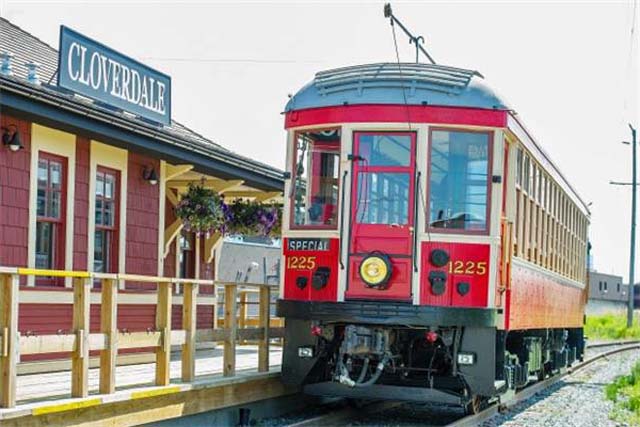
| 

BC Electric interurban at the new Cloverdale station - Date/Photographer unknown.
17 July 2013 The Return of the Interurban Rail System Cloverdale British Columbia - On 28 Feb 1958, rail car number 1225 of the BC Electric left Steveston and pulled into the Marpole station at 1:30 a.m.
An era, and a piece of the Fraser Valley's history, ended with that trip. The Interurban, the beloved web of track and cars that connected Vancouver to Chilliwack and points in between, had made its last run. The reign of rail had ended: The Age of the Car had begun.
But a group of volunteers, backed by a consortium that includes the City of Surrey, BC Hydro, and Southern Rail of B.C., have brought a working portion of the old Interurban back, complete with rail car number 1225, now 100-years-old.
The result is, in a word, spectacular.
The 7.4-kilometre track is on an original portion of the Interurban line, from 176A Street near Highway 10 in Cloverdale to the intersection of 64th Avenue and 152nd Street, in the old Surrey neighbourhood of Sullivan. It runs through some of Surrey's busiest areas to some of its most bucolic. And at each terminus are working copies of the Cloverdale and Sullivan rail stations, built from historical records to be exact replicas of the originals (with some modern touches added, like wheelchair accessibility).
And rail car number 1255, rescued from the Orange Empire Railway Museum, in Perris, California, USA, where it had languished for years, has been restored to pristine condition, with its original bright red and buttermilk colour scheme. The restoration took four years and 20,000 man-hours, all of them volunteer.
The line, dedicated in late June, opened for business two weekends ago, and in four working days has already carried more than 1,000 passengers. It operates only on Saturdays and Sundays between 10 a.m. and 3 p.m., and the round trip, $10 for adults and $5 for children, takes just under an hour. It travels at a stately 25 km/h.
"The old rail cars," said Henry Ewert, a local historian who's written four books on the Interurban, "could go 80 km/h easily, and often did.
"The first Interurbans began in 1891, between Vancouver and New Westminster, and the line out to Chilliwack began in 1910. That line was the first, real transit option open to people then, and the building of the line in 1910 absolutely opened up the Fraser Valley. For the first time, people could take day trips, visit between city and country, buy property. It was an integral part of the development of the valley. It was phenomenal."
Ewert himself remembers riding the Interurban in the 1940s with his parents, going from Mount Pleasant to Chilliwack to visit his Mennonite relatives. The 120-kilometre trip would take just over three hours, with the windows of the tram car wide open and the countryside rolling by. They'd stop at stations with names like Warwhoop, Bradner, Dennison, Evans Thomas, and Sardis.
"You'd cross the bridge at New Westminster, which was a big deal even then, and you'd climb up Scott Road, and after Newton, you were gone, you were out in the valley. Oh, it was wonderful. Suddenly, you'd see Mount Baker, and for a boy living in Mount Pleasant, it was like climbing a stairway to heaven."
At its height, the BCER operated 500 streetcars and 73 Interurban cars on almost 500 kilometres of track. During the war years, when rationing made driving difficult, the BCER carried over 140 million passengers annually. (In 1945, its peak year, the BCER carried 144.4 million passengers, and carried 833,000 tonnes of freight to boot. As comparison, the entire SkyTrain system in 2010, the Olympic year, carried 117.4 million passengers.)
With the war's end, the long decline of electric rail began. But the fondness for the BCER survived, and in 1996, the Surrey Heritage Advisory Commission came up with the idea of the possible restoration of part of the line.
Following a four-year feasibility study, the Fraser Valley Heritage Railway Society was formed. The society acquired two Interurban cars, the aforementioned BCER number 1225, and BCER number 1304, an original Chilliwack rail car the society found in the Oregon Electric Railway Museum in Glenwood, Oregon, USA. (The society has since acquired a third tram, a BCER streetcar which was last doing active duty in Lisbon, Portugal.) When BCER number 1304 is restored, there are plans to incrementally expand the rail line west to Newton, Kennedy, and Scott Road, where it will link up to the SkyTrain station there. The society hopes to be at Scott Road in five to six years, with both cars and three more stations operating on the line.
"The value of this project," said Allen Aubert, secretary of the society and chair of the original feasibility study, "is about $7.5 million in cash donations, volunteer work, and in kind services. I would say there's probably in excess of 250 corporate and individual donors, a core group of about 50 to 60 volunteers and a membership of 380."
Riding the existing line is, simply, a delight. The interior of BCER number 1225 is pristine, with the leaf green painted interior contrasting with the bright yellow replicas of the original BCER rattan benches (with imported Indonesian rattan woven in a "railway" weave). There is dark wood and bright brass fixtures throughout, and the wood windows open to let in the breeze. The car even has a "smoking area", with wood benches and inlaid match strikes, and original advertisements overhead. ("Burnett's Vanilla," "Rest-Arch Shoes For Women," "HomeKraft Bread.")
And when it moves down the track, you can hear not only the sound of the rails but the creak and groan of wood. It is sweetly pleasant, with something organic about it, if that's the right word. It's moving, this moving bit of history, a remembrance of a slower time.
Aubert was asked if people ever ask him why we readily gave up something so pleasant.
"Oh," he said, "we get that. We get that all the time."
Pete McMartin.



Vancouver Island
British Columbia
Canada
|